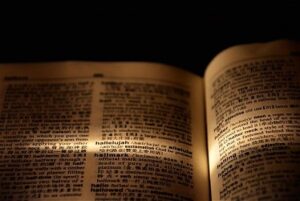
I’m not really going to cover the millennia of this word’s usage; there are whole books on the subject. Instead, I’ll concentrate on the word itself and on pieces my choir has sung that include it. I will include a brief foray into its usage in Shrek, though, so keep going to the end if you want to get that!
It’s stunning to look at the pieces that are either totally built around this one word or include it as a significant part of the lyrics. Why is it so powerful and attractive? Such questions are always in the end unanswerable. I’d postulate, though, that the sound of the word itself and its use as an exclamation of praise can claim at least partial credit. Why are there two spellings, by the way? Very simple: “hallelujah” is a transliteration from the Hebrew Old Testament and “alleluia” is a Latinized version of the same word in Greek.
So what does the word mean? Its literal meaning from the Hebrew comes as a combination of two shorter words:
Hallelujah is a transliteration of the Hebrew phrase הַלְלוּ יָהּ (halelū yāh), which means “praise ye Jah!” (from הַלְלוּ, “praise ye!” and יָהּ, “Jah.”) The word hallel in Hebrew means a joyous praise in song. The second part, Yah, is a shortened form of YHWH (Yahweh or Jehovah in modern English). (Wikipedia)
Most of the word’s Scriptural uses come from the Hebrew Psalms, with another famous usage in the Christian New Testament Book of Revelation. Some uses of the word clearly reference one or more of those passages; others use just the word by itself or as an addition to another text.
So here are two of the stand-alone settings:
First, the Randall Thompson version: Why Is Randall Thompson’s “Alleluia” So Mournful?
Then the very, very different and equally great Paul Basler version, which the J. W. Pepper sheet music company describes as “full of energy and contrast. Buoyant, earthy, ethnic, reverent – in short, this wonderful piece by Paul Basler truly runs the gamut of dynamics, vocal timbres, styles and covers a multitude of ways of praising God! The piano and horn are equal counterparts to the choral ensemble making this piece a true work of art.” Also a real challenge to sing, as my own choir has discovered!
Note the length of this performance (well under 5:00, which seems to be a good benchmark) and that Paul Basler himself is playing the horn part:
And here’s a classic by the Polish-Jewish-German composer Louis Lewandowski that uses the text of the Hebrew Psalm 150. Such a joyful piece, with its recitation of all the musical instruments that are to be used in God’s praise! Different translations use different words for the instruments, but the overall idea is that there’s a whole ensemble’s worth of them. So as you sing or listen to the piece you should think of the blast of a shofar, or ram’s horn, the strumming of strings, the shaking of tambourines, and the playing of pipes. All in accompaniment to dancers performing along with it.
Here’s a performance totally in the spirit of the original:
And, finally, Handel’s perhaps-overexposed “Hallelujah Chorus”: I wrote some material about this piece several years ago. Scroll down about halfway through the post to find the section on it, or read the whole thing: Where Did Composers Haydn and Handel Get Their Ideas?
And what about that Shrek reference in the title? Well, sigh. It’s a shortened version of the pop musician Leonard Cohen’s version, which has a gorgeous melody and very strange words. Apparently the composer was also a poet and had written dozens of verses. When the actual recording took place, though, he had to cut it down to five. The scene in the movie takes place after the ogre Shrek has had a fight with his love the Princess Fiona. The film’s directors considered many “sad songs” before choosing this one. Kind of ironic when “hallelujah” is a shout of praise, right? So here it is, for what it’s worth:
Don’t worry–everyone gets together in the end, with Fiona becoming an ogress. It would be nice if they’d done a happy version for the wedding, but there it is.

